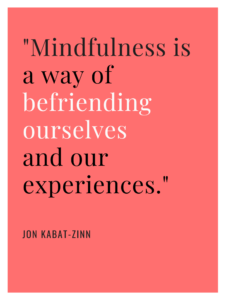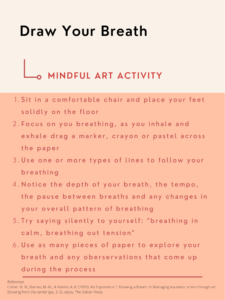

by Bridget Cybulski
Our subconscious minds carry so much meaning in our daily thoughts, feelings, concerns, and reactions. Not only are our emotions affected by our subconscious needs pulling at us, but our bodies often feel that pull first. Whether it’s a shift in energy in our space or by our partners, our bodies usually respond first to this shift in energy.
The challenge of engaging in mindfulness is focusing solely on the present moment and emotions. However, that can feel so limiting when much of our current feelings gather influence from the past and future. Though, the past and future can hold space in the present in mindfulness practice. The goal is not to avoid past feelings or future concerns but rather to acknowledge their weight in the area of the present moment.

Whether we are pursuing a solution in the present moment to stop any reoccurrence of an experience/feeling or avoiding the situation altogether, both reactions are pushing and pulling us from the present.
Sometimes the solution is unknown, and there is no decision to make at this time, but certain emotions are coming up to tell us otherwise. It’s incredibly uncomfortable to sit with our feelings! Even sitting with the discomfort of not knowing how to respond to emotion is a part of mindfulness. Tuning in to where you are at emotionally, physically, and mentally are aspects of this practice of becoming more aware of your needs.
What To Do?
Have you ever felt like the more you try to avoid a feeling, the more it builds up in your body, almost as if that feeling is demanding your attention? What would it be like to notice its presence? Could you imagine that feeling as color, size, sound, facial expression, or gesture?
I’m not asking you to absorb or push away the feeling, but consider giving space to it and witnessing its shape. Giving space to the feeling is, in a way, permitting its expression. How can we allow a feeling to enter our space that makes us so uncomfortable? So much of that feeling is already taking up space inside of you. It may take shape through physical tension, rumination, or nervousness. I understand wanting to run from that feeling. In some ways, you may not even be conscious of how you are trying to protect yourself from experiencing that feeling.
Mindfulness might be foreign to many people because it has not been a part of your education, training, or upbringing. Slowing down and noticing your surroundings may not feel like you have time. When would you? On your lunch break? Well, maybe. When you’re feeling stressed at the office and notice you have time to go for a coffee, while you’re making your way there, could you slow down your pace and notice your posture? Take a breath as you catch some tension in your neck and acknowledge it. Thinking deeper about where the stress comes from, sitting with that feeling – not absorbing it or throwing it away, just being with it.
Sometimes being with a feeling can take you out of your routine by tending to your needs slightly differently. Mindfulness is accommodating to your life; it does not necessarily have to be supplementary through yoga or stretching, but in some ways, you might need to shift your mindset to create space for these mindful moments.
Yes, yoga and meditation are great mindfulness practices! However, you can use mindfulness in other activities such as reading a book, taking a walk, lying on the grass, cooking, and more. Any activity can be mindful if you slow it down and focus on the movements of it. Remaining present in the moment of the activity is the main goal of applying mindfulness to activities that you probably already do but may have a hard time focusing on in the present moment. Shifting your intention may help ground you in being more mindfully aware of the action and emotions coming up for you throughout the moment. Ultimately, being mindful is not a perfect practice, but continuing to apply it as a form of slowing down and taking time for yourself can support you in processing emotions more calmly and communicating your needs with yourself and others.
Mindfulness Exercises
More than simply acknowledging the feeling, what do I do with it? Well, in accepting the feeling, could you check in with your body and understand what you might need? Our body is the most susceptible to stress – changes in sensation and changes in the environment. Could you sit briefly and settle into your body using a body scan? To start, focus on from the top of your head and scan down to your toes, noticing any tension or aches that pull in your attention?
- Draw its shape, or pick a color that you feel it is holding and place its color on a piece of paper.
- If it is hard for you to materialize its shape or color, can you tap into how the feeling is moving in your body? What does the energy remind you of? Can you think of a texture or movement or direction it’s going in?


- Another way to use art in a mindful way is through an exercise called, “draw your breath”
- Try writing down the recurring thought or feeling and be curious about it. Where might it be coming from, who was I with, what happened? Can I think back to another time I felt this way? What is the meaning of the shift in energy that your body is feeling?
- If you’re having difficulty identifying the feeling you’re experiencing, look at this emotion wheel to support you in being curious about the feeling. Even just identifying the feeling could relieve some of the tension it is stirring up in your body.


